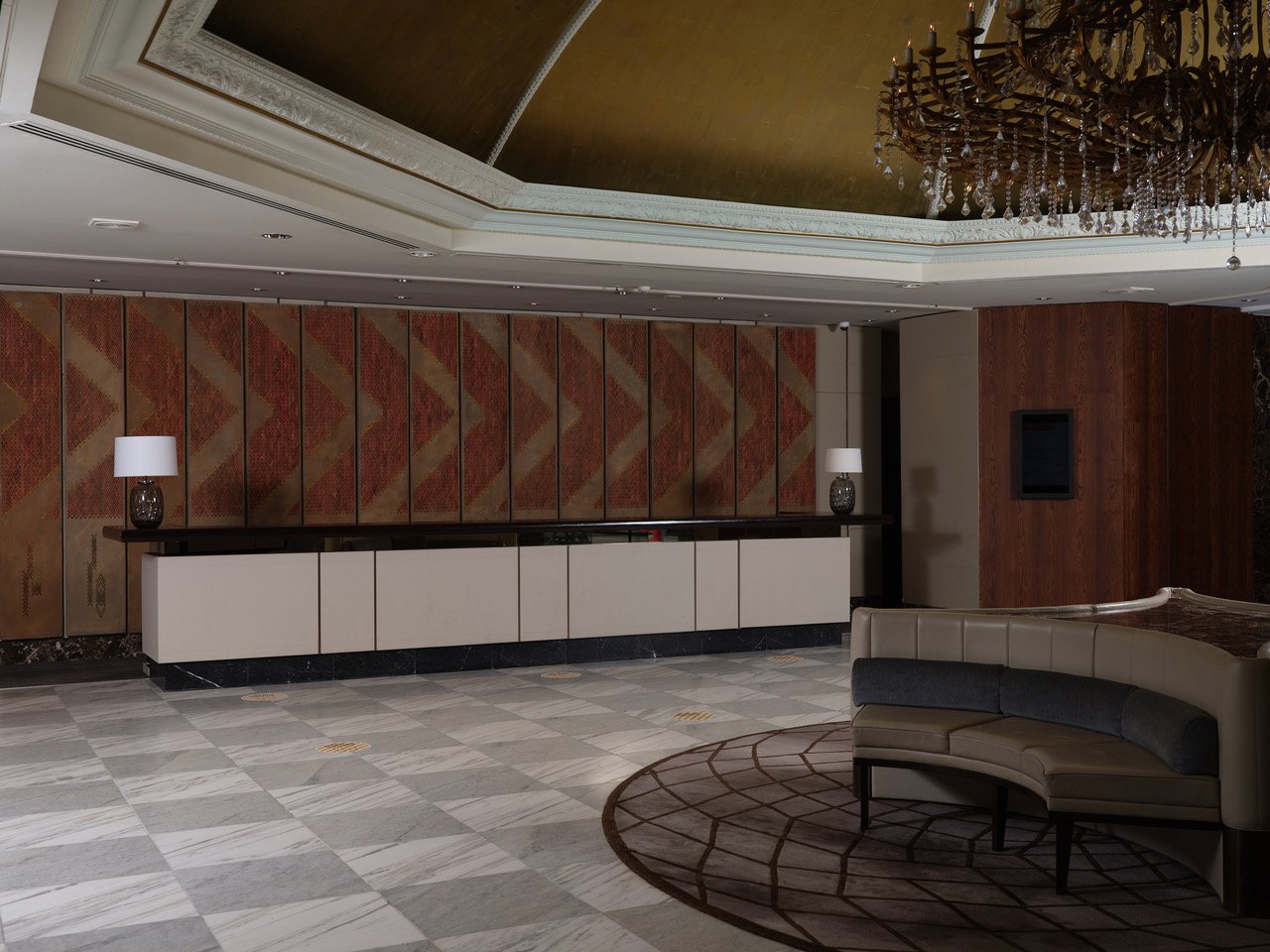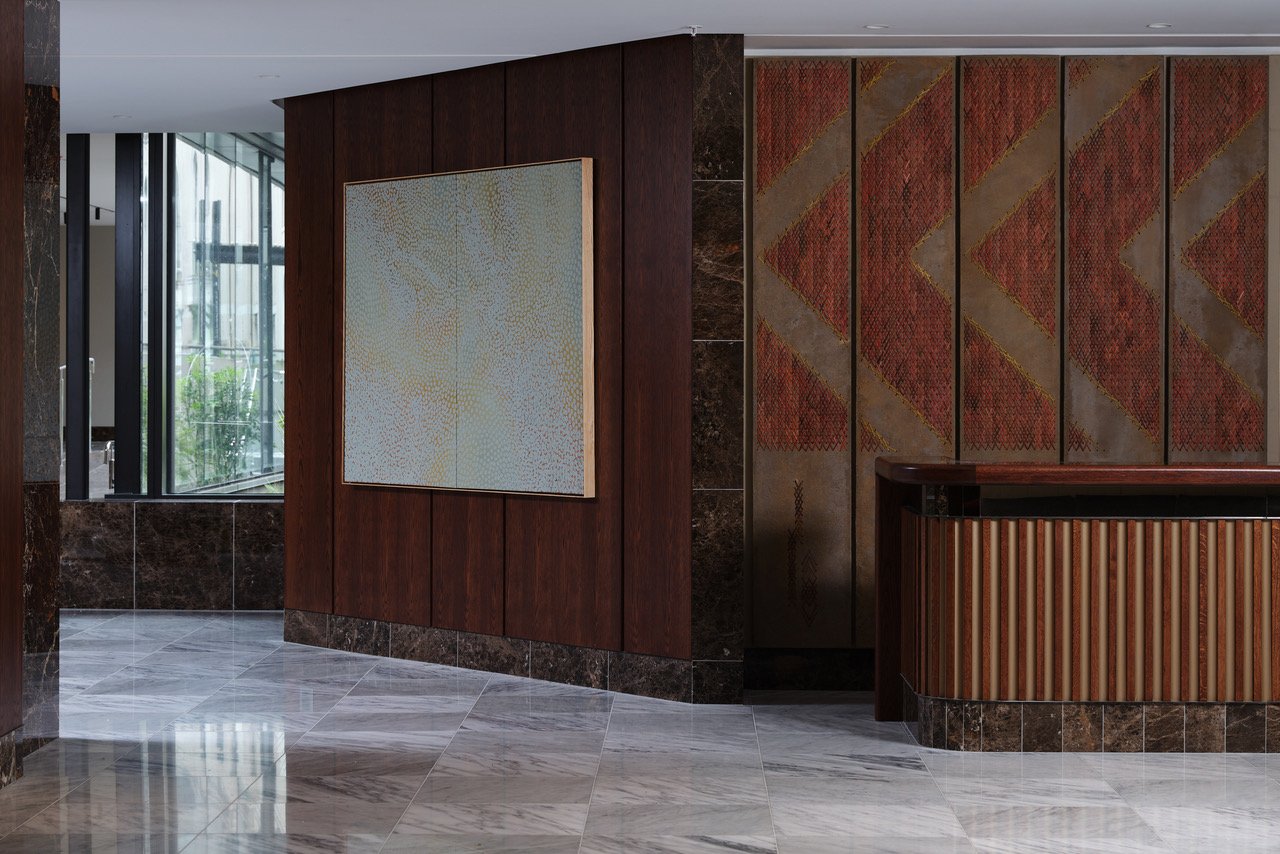Ki Mua, Ki Muri
Collaboration by Beronia Scott and Carla Ruka
Project management: Emily Cormack & Sophie Coupland of Coupland Art
At the heart of the Cordis Auckland art collection are the large woven panels entitled Ki Mua, Ki Muri, located in the hotel’s reception. This key work within the Cordis Auckland curatorial narrative embodies the ideas inherent within the collection of manawa and kaitiakitanga, and brings the art of tukutuku weaving into the current moment in a distinctly contemporary reinterpretation of traditional techniques and ideas.
Ki Mua Ki Muri the Māori whakataukī, or proverb, talks of walking backwards into the future - knowing your past and where you come from stands you in good stead going forward and pays respect to the importance of tradition when moving into the future. This series of 21 panels – a collaboration between Beronia Scott and Carla Ruka, with weaving by Te Pūawai Ōrākei Marae – greets the guest as they cross the entrance threshold, inviting them to become part of the curatorial story, and to experience the natural materials and whenua of Aotearoa within the hotel environment.
Ki Mua, Ki Muri rethinks the traditional practice of tukutuku – traditional Māori weaving using reed latticework. Typically, tukutuku adorns the inside walls of wharenui (meeting houses), conveying a complex language of visual symbols. The ornate tuinga (X shapes) of the tukutuku are woven around the dried stalks of the toetoe plant and form a symbol of strength and unity – a weaving together of parts to create a whole.
For this artwork, rather than weaving tukutuku into toetoe stems, the artists have woven into large panels within which is incorporated the sand and grit of Tāmaki Makaurau’s whenua. Uku (clay) artist Carla Ruka engrained the panels with elements from Tāmaki Makaurau’s volcanic whenua, embedding texture and substance into the substrate thus ensuring that the works hold the power of the earth. Woven into these textured panels are pīngao and kiekie fibre – natural fibres from native plants. Pīngao is golden in colour and referred to as a fibre of prestige, and kiekie is a native vine of glowing golden fibre, which ranges in colour from pale cream to strong yellow. These fibres were dried and dyed, using the bark of the tānekaha, a native tree treasured for its strong wood, medicinal qualities and unique red/brown dyeing properties, which are used extensively by highly regarded weavers in Aotearoa.
Formed in the small stitches of tukutuku weaving is a vast pattern that spans the entire length of the 21 panels. The angled kaokao pattern is an important Māori form that signifies strength and protection, drawing on the shape created by the arm in an embrace or by the warrior’s upheld arm as they give shelter and protection. The kaokao pattern is also the shape of the ribs, which protect the heart, and is usually placed in each of the four corners of a whare (house), giving protection to all who enter.
Beneath the kaokao pattern in the lower section is an irregular arrangement of the same traditional weaving stitch, each piece representing an important date for Ngāti Whātua Ōrākei and Cordis Auckland – intertwining the two stories and celebrating the relationship between Ngāti Whātua Ōrākei and Cordis Auckland. Present across the panels are key dates, such as: 1840 – Te Tiriti o Waitangi is signed by Ngāti Whātua Ōrākei representatives; 1865 – the first Langham Hotel opens in London; and 1988 – a small part of confiscated land is returned to Ngāti Whātua Ōrākei in Tāmaki Makaurau. Locating these key dates beneath the protecting arms of the kaokao ensures the respectful interconnection of histories, bringing the past and the present together in a moment of heartfelt connection, which enables ki mua, ki muri – moving forward in knowledge of the past.
Beronia Scott
Beronia Scott (Ngāti Whātua Ōrākei)
Beronia Scott is an inspiring leader of mahi toi through her skills of raranga, the art of Māori weaving and is the lead weaver at Ngāti Whātua Ōrākei. Scott started her journey with the teachings from Aunty Alice Pihema and continued learning through Te Wānanga o Aotearoa. With all her knowledge, she has continued Aunty Alice's teachings by sharing these traditional practices through whānau wānanga over several years. As a recognised Ngāti Whātua Ōrākei weaver within the world of mahi toi, Scott continues to gift her talents back to the iwi and beyond. Scott’s mahi can be found in Tumutumuwhenua and around the country. She has created works for Park Hyatt Hotel, Tāmaki Makaurau; collaborated with artist Numangatini Mackenzie at ASB’s head office in Wynyard Quarter to create Te Whiri, two contemporary installations: A tutukuku panel and weaving wrapping three pillars outside the entrance. Each artwork incorporates modern and recycled materials. At Cordis Auckland she collaborated with uku artist Carla Ruka and the work was woven by Te Pūawai Orākei Marae.









